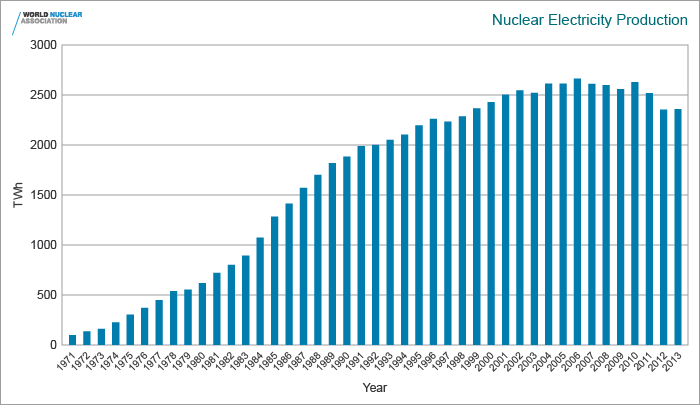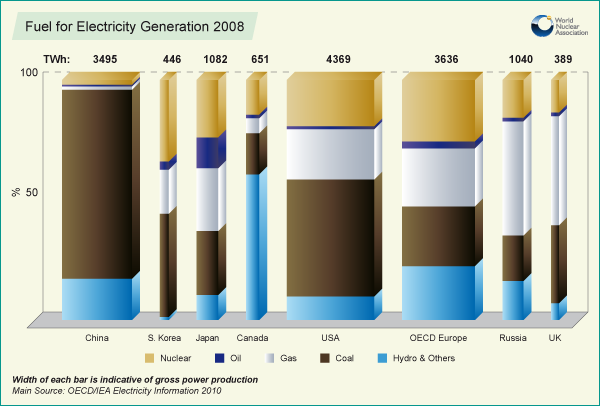- The first commercial nuclear power stations started operation in the 1950s.
- There are now over 440 commercial nuclear power reactors operating in 30 countries, with 377,000 MWe of total capacity.
- They provide about 14% of the world's electricity as continuous, reliable base-load power, and their efficiency is increasing.
- 56 countries operate a total of about 250 research reactors and a further 180 nuclear reactors power some 140 ships and submarines.
Nuclear technology uses the energy released by splitting the atoms of certain elements. It was first developed in the 1940s, and during the Second World War research initially focussed on producing bombs by splitting the atoms of either uranium or plutonium.
In the 1950s attention turned to the peaceful purposes of nuclear fission, notably for power generation. Today, the world produces as much electricity from nuclear energy as it did from all sources combined in 1960. Civil nuclear power can now boast over 14,000 reactor years of experience and supplies almost 14% of global electricity needs, from reactors in 30 countries. In fact, many more than 30 countries use nuclear-generated power.
Many countries have also built research reactors to provide a source of neutron beams for scientific research and the production of medical and industrial isotopes.
Today, only eight countries are known to have a nuclear weapons capability. By contrast, 56 operate civil research reactors, and 30 host some 440 commercial nuclear power reactors with a total installed capacity of over 377,000 MWe (see table). This is more than three times the total generating capacity of France or Germany from all sources. Over 60 further nuclear power reactors are under construction, equivalent to 17% of existing capacity, while over 150 are firmly planned, equivalent to 46% of present capacity.
A list of the countries with nuclear power projects is
appended.
Sixteen countries depend on nuclear power for at least a quarter of their electricity. France gets around three quarters of its power from nuclear energy, while Belgium, Bulgaria, Czech Republic, Hungary, Slovakia, South Korea, Sweden, Switzerland, Slovenia and Ukraine get one third or more. Japan, Germany and Finland get more than a quarter of their power from nuclear energy, while in the USA one fifth is from nuclear. Among countries which do not host nuclear power plants, Italy gets about 10% of its power from nuclear, and Denmark about 8%.
Improved performance from existing nuclear reactors
As nuclear power plant construction returns to the levels reached during the 1970s and 1980s, those now operating are producing more electricity. In 2007, production was 2608 billion kWh. The increase over the six years to 2006 (210 TWh) was equal to the output from 30 large new nuclear power plants. Yet between 2000 and 2006 there was no net increase in reactor numbers (and only 15 GWe in capacity). The rest of the improvement is due to better performance from existing units. In 2007 performance dropped back by 50 TWh due to plant closures in Germany, UK and Japan.
In a longer perspective, from 1990 to 2006, world capacity rose by 44 GWe (13.5%, due both to net addition of new plants and uprating some established ones) and electricity production rose 757 billion kWh (40%). The relative contributions to this increase were: new construction 36%, uprating 7% and availability increase 57%.
One quarter of the world's reactors have load factors of more than 90%, and nearly two thirds do better than 75%, compared with about a quarter of them in 1990. For 15 years Finnish plants topped the performance tables, but the USA now dominates the top 25 positions, followed by Japan and South Korea.
US nuclear power plant performance has shown a steady improvement over the past twenty years, and the average load factor now stands at around 90%, up from 66% in 1990 and 56% in 1980. This places the USA as the performance leader with nearly half of the top 25 reactors, the 25th achieving more than 98%. The USA accounts for nearly one third of the world's nuclear electricity.
In 2009 and 2010 nine countries averaged better than 80% load factor, while French reactors averaged 73%, despite many being run in load-following mode, rather than purely for base-load power.
Some of these figures suggest near-maximum utilisation, given that most reactors have to shut down every 18-24 months for fuel change and routine maintenance. In the USA this used to take over 100 days on average but in the last decade it has averaged about 40 days. Another performance measure is unplanned capability loss, which in the USA has for the last few years been below 2%.
Other nuclear reactors
In addition to commercial nuclear power plants, there are about 250
research reactors operating, in 56 countries, with more under construction. These have many uses including research and the production of medical and industrial isotopes, as well as for training.
The use of reactors for
marine propulsion is mostly confined to the major navies where it has played an important role for five decades, providing power for submarines and large surface vessels. About 140 ships are propelled by some 180 nuclear reactors and over 13,000 reactor-years of experience has been gained with marine reactors. Russia and the USA have decommissioned many of their nuclear submarines from the Cold War era.
Russia also operates a fleet of six large nuclear-powered icebreakers and a 62,000 tonne cargo ship which are more civil than military.
It is also completing a floating nuclear power plant with two 40 MWe reactors for use in remote regions. Note: Taipower uses nuclear energy to generate 22% of electricity on the island of Taiwan.
Note: Taipower uses nuclear energy to generate 22% of electricity on the island of Taiwan. See
table of the World's Nuclear Power Reactors which complements this paper.













